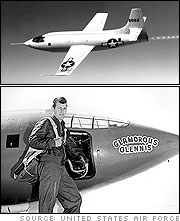Experimental and Spy Planes: Bell X-1

A plane that went faster than the speed of sound
by David Noland
 Bell X-1 Specs
Related Links |
On October 14, 1947, legendary test pilot Chuck Yeager became the first man to fly faster than Mach 1, the speed of sound. He was piloting the Bell X-1, a bullet-shaped rocket plane that was the first in a series of secret high-speed research aircraft. The X-planes came to symbolize the danger and glamour of test flying at California's Edwards Air Force Base in the late 1940s and 50s.
Originally known as the XS-1, the X-1 was powered by a Reaction Motors XLR11-RM3 rocket engine. Its four chambers each produced 1,500 pounds of thrust. At full power, the engine burned up its 600-gallon supply of liquid oxygen and alcohol fuel in less than three minutes.
Ferried by a B-29 Bomber
Because of its limited endurance, the X-1 had to be lifted to an altitude of 20,000 feet under the belly of a converted B-29 bomber. It then dropped free and fired its rocket engine. After running out of fuel, the X-1 would glide down for a dead-stick landing on Muroc Dry Lake.
The advantages of swept wings for supersonic flight were as yet unknown, so the X-1 had straight, very thin wings. The shape of its fuselage was modeled after a .50 caliber machine-gun bullet. To maintain its bullet shape, the X-1's cockpit canopy was flush with the fuselage, which severely limited visibility.
An unusual design feature of the X-1 was its all-moving horizontal tail, which could be adjusted up and down, or "trimmed." This turned out to be critical when Yeager found that the X-1's elevator control became useless above Mach 0.94. The trimmable tail served as an impromptu backup pitch control as the X-1 flew through the sound barrier and into the history books.
Glamorous Glennis
During 157 test flights from 1946–51, the X-1 achieved a maximum speed of Mach 1.45 (957 mph) and an altitude of 71,902 feet, both world bests at the time. The X-1A, a later version with larger fuel tanks and an improved cockpit, reached 1,650 mph and 90,000 feet.
Three X-1s were built. The Mach-busting aircraft, which Yeager named "Glamorous Glennis" after his wife, is currently on display in the National Air & Space Museum in Washington D.C. The No. 2 aircraft, which was later modified and renamed the X-1E, can be seen at Edwards AFB. The third aircraft exploded on the ground in 1951 and was destroyed.








